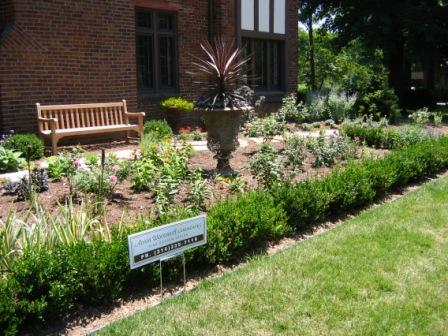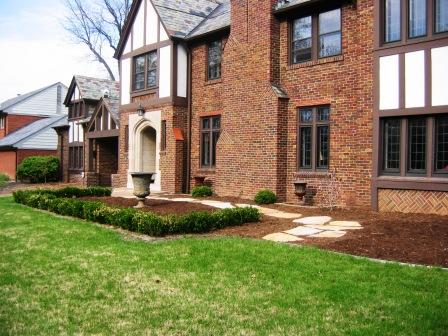Today I’m going to detail my design process in hopes of giving those readers who may be interested in hiring a professional garden designer some insight into the process. This information may be helpful to other designers as well. Keep in mind, this is just how my business operates. I have refined this business model over several years to accommodate my small operation. Your experience will likely vary.
Most often, new clients contact me via telephone and have often been referred by an existing client. I will generally ask several questions to ‘qualify’ the potential client. I typically mention the range for design fees and project costs in this first conversation. Being straightforward is essential for me: it saves valuable time and energy. Before doing that, I spent many hours working on projects that never came to fruition.
Once I decide to proceed with a client, I schedule a preliminary consultation on site. This is typically an hour-long visit and a tour of the property. It’s a time to identify landscape opportunities and evaluate client ideas. I encourage clients to do some homework before this meeting. I suggest pulling photos from books and magazines that represent styles, plant materials, etc. that they like. It’s important to consider dislikes as well: colors, flowers, fragrance, etc.
The preliminary consultation is also a time to determine if we mutually agree that a working relationship would be beneficial. I cannot stress enough the importance of trusting your instincts! I know from past experience that when I questioned the ‘fit’ with a particular client and went against my gut, I later felt I had somehow compromised my professional integrity. Let’s face it: not everyone values the creative process in the same way. A good working relationship between designer and client is essential to the success of a design.
From the client’s perspective, if you have not been referred to the designer, ask to see examples of his or work and check references. Even after seeing examples of their work, if you are in the least bit hesitant about commissioning a design, trust your instincts and hold off on making a decision until you are convinced either way. This designer may not be a good ‘fit’ with you.
I charge a fee for a preliminary consultation. It is a part of the qualifying process to make certain the potential client is serious about a project. Following the consultation, I prepare a written estimate for design services. The client is asked to sign a Design Agreement and submit a 50% retainer to start the design. I have become quite protective of my creative output in recent years, so among other things, the Agreement addresses ownership of the plans, ideas, and information generated during the design process. Additionally, it protects the design intent and a significant revenue stream by indicating that landscape design services are provided only to clients who intend to contract with me for installation and implementation.
If you are a designer, do you use a Design Agreement? If you are a potential client, how do you feel about signing a Design Agreement that favors the designer you are hiring and protects their creative output?
Once the Agreement and retainer are received, I schedule a completion date to present the design (typically some weeks to months out) and return to the site for further analysis, measurements, and photographs. Keep in mind that it is always helpful when the client provides a detailed site plan. It saves a great deal of time locating details, like terrain, property lines, buildings, utilities, existing plant materials, etc. More often than not, however, I am on site taking detailed measurements by hand. With this information, I prepare a base plan. The base plan is a to-scale drawing of the project area. It is the basis for further design sketches and drawings.
Until recently I worked with fade-out vellum and pencil. Fade-out vellum is essentially graph paper in which the grid disappears when photocopied. You can imagine how time consuming it is to make changes to a design by hand. So, in December I decided to make my life a little easier and I purchased DynaSCAPE Landscape Design Software. I am still in the learning phase and I’ll post more on the software at a later date when I am better versed on the topic. I will tell you the features and output are impressive!”
With the base plan complete, I return to the site, often multiple times, to conceptualize a general design. It is helpful for me to do this in person, rather than referencing photos. In a previous post, I mentioned the best ideas come to me as I lie in bed at night with my eyes closed, visualizing the site. I suppose the ability to do this comes from spending a significant amount of time on site. As a designer, what works for you? Do you rely more on photos than time spent on site?
In the studio, I use tracing paper to sketch over the plan and work out the location of key structural plants, bed lines, hardscape elements, etc. When I am satisfied with the rough sketch, I meet with the client to confirm their comfort with the direction of the design. At this point, herbaceous plantings (perennials, annuals) are represented with photos. They are detailed in the final conceptual plan. The design development and client review process may take several revisions depending on the size of project.

Residential- Post planting, season one
Using feedback from the client reviews, I draft a final conceptual plan and return to present my detailed vision for the site. Visual aids and samples are invaluable at this stage. Following client approval of the plan, I begin the process of estimating costs to implement the design.
I want to reiterate, this is my design process, and it has been relatively successful for me. There are other ways to go about this. If you are a client looking to hire a designer, ask for some clarity around what to expect as you proceed. If you are a designer, I am interested in how your design process varies from what I have outlined above.



